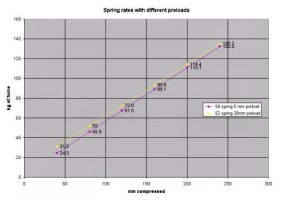Me being a newbie to the wonderful world of suspensions, I was pondering a couple of things, and wanted to post here to see if I had my thinking straight.
1.) If I have a spring that is rated at .54 kg/mm multiplying .54 by 2.2 would give me lbs/mm. Then by multiplying that product by 25.4 should give me lbs/inch.
Is this correct?
2.)When a spring (lets use .54 again) is compressed it takes .54 kg of force to compress it 1 mm. If I compress it another mm(2) does it take a total of 1.08kg of force to complete the task? Or, am I missing some piece of the puzzle?
3.) I'm trying to fully understand the difference between having a spring at one rate with a little bit of preload, and running a lighter spring with more preload. So, I kinda need to understand #1 and !2 before I can finish mulling over #3.
thanks
1.) If I have a spring that is rated at .54 kg/mm multiplying .54 by 2.2 would give me lbs/mm. Then by multiplying that product by 25.4 should give me lbs/inch.
Is this correct?
2.)When a spring (lets use .54 again) is compressed it takes .54 kg of force to compress it 1 mm. If I compress it another mm(2) does it take a total of 1.08kg of force to complete the task? Or, am I missing some piece of the puzzle?
3.) I'm trying to fully understand the difference between having a spring at one rate with a little bit of preload, and running a lighter spring with more preload. So, I kinda need to understand #1 and !2 before I can finish mulling over #3.
thanks

